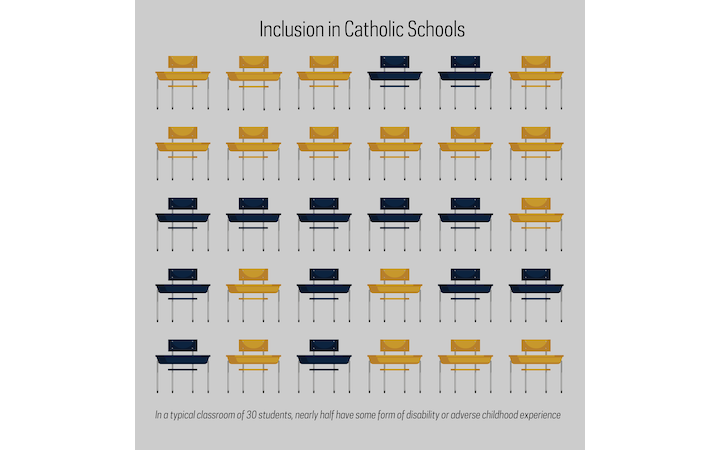Catholic schools are called to serve all students. We see this call in scripture, Church documents, and in Catholic Social Teaching. In the Old Testament, it is clear through the stories of creation and deliverance that each person has God-given dignity, for we are made in His image. In the New Testament, there are countless examples of community and inclusion, as Jesus reached out to the margins and welcomed all people — speaking, gathering, and breaking bread with them. Jesus was the radical includer! Church documents support the inclusion of people with disabilities, the poor, and refugees. All are Welcome should be more than rhetoric...it should be joyously practiced.
Catholic schools have often been selective about who they include — under-serving individuals with learning needs and those diagnosed with disabilities. However, our classrooms have become more diverse including students with hidden disabilities, such as learning disabilities, anxiety, and attention-deficit hyperactivity disorder. In a typical classroom, nearly half of our students have some form of disability or adverse childhood experience, and these characteristics affect their learning. Hence, I contend...inclusion is here!
Given the different learning styles, attributes, and needs we encounter in our classrooms, we must be prepared to remove barriers and provide access to learning for every student. Using a lens of Universal Design for Learning (UDL), educators can use multiple ways to engage students, provide content, and assess what they know. We simply have to be willing to think outside of the proverbial box and explore creative ways to meet the needs of our students. When we are proactive with our planning and designing using data to make decisions, we meet everyone's needs....not just those who struggle.
Consider the student in your classroom who is disengaged and off-task during a specific content lesson. This disengagement happens often and the student slips further behind. Moreover, you spend far too much time redirecting and assisting, which disrupts the classroom routine and instruction. Many times, we make assumptions about this student...perhaps potential ADHD or even student motivation. However, several things could be occurring aside from these possibilities.
Understanding the ABC behavioral chain, including the triggers of behavior (antecedents) and the situations that follow a behavior (consequences), in relation to the corresponding purpose (function), can save educators a lot of time. What is the reason for the off-task behavior? In addition, we must ask whether there is a skill deficit or a performance deficit. Is the student who is disengaged a can't doer...or a won't doer? When we can identify the situation in which behaviors happen and why they occur, we can intervene and make changes successfully.
Intervening with a skill vs. a performance deficit requires two very different approaches. When a student has a skill deficit (can't do something), we teach. But, when a student has a performance deficit (won't do it), then we need to motivate.
The student above could be disengaged because of a lack of skills. Perhaps the work is too difficult or the student lacks knowledge about the routine or procedure. In this instance, getting the student engaged will require them to learn new skills. If the student is disengaged for other reasons, such as boredom or a lack of motivation, we must find ways to engage and sustain attention with better reinforcers for the correct behavior.
Educators do not need to reinvent the wheel. The research is flooded with evidence-based practices (EBPs) across different content and developmental areas. EBPs are effective strategies validated by research to support student learning and behavior. They work! Select an EBP that addresses the need (skill vs. performance deficit) and implement it with fidelity, monitoring behavior change to determine if it is successful.
So when educators encounter a student who exhibits behaviors that interfere with learning, it is critical to determine the purpose of the behavior. We must collect data to make good decisions about intervention by exploring triggers and reinforcing events. We select evidence-based practices to address the behavior, and then proactively plan to remove future barriers. This process allows students to achieve success.
The Program for Inclusive Education offers in-depth exploration of these foundational concepts and practices that you can quickly implement in your classrooms. PIE fosters inclusive culture, offers research-based instructional practices, and builds a national community of like-minded inclusive Catholic educators experiencing the same successes and struggles. Lifelong friendships are formed. This remarkable, educational transformation occurs while we grow closer in our faith with one another.
As Catholic schools become more diverse, we can better serve our students. In addition, we can do more to welcome students with more significant needs and provide them with the opportunity to participate in Catholic education. The Program for Inclusive Education welcomes your commitment to join our mission as we Welcome, Serve, and Celebrate ALL students in Catholic schools. Inclusion is here!
There's still time to join our next cohort of Inclusive Educators! The deadline for applications is April 1st or until all seats are filled.
 Alliance for Catholic Education
Alliance for Catholic Education
